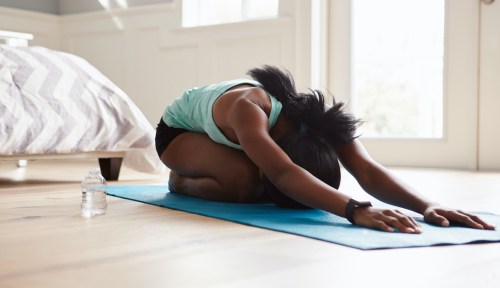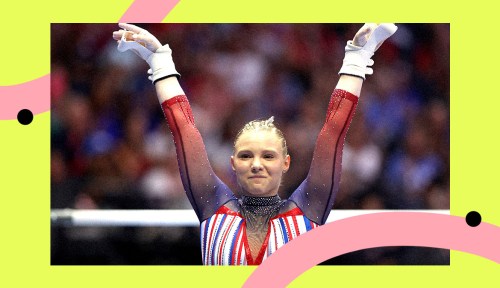There are a few telltale signs that you might be feeling run-down—and these hold true no matter how much sleep you’re getting. Aside from the standard soreness that can come with pushing your body too hard physically, you may be struggling to focus (brain fog, anyone?), dealing with increased moodiness and irritability, and feeling chronically exhausted. When you’re feeling this type of all-encompassing blah-ness, it makes sense if the last thing you want to do is pull out a mat and get moving. But according to experts, cycling through a few restorative movements when you’re run-down might just be exactly what you need for a body and brain reset.
Experts in This Article
Danyele Wilson is a NASM certified trainer and a coach with Tone and Sculpt, a female-focused fitness app offering on-demand classes, comprehensive workout plans and nutrition tools.
ACE certified trainer, functional training specialist and running coach with the EvolveYou app
The reason? These types of movements can help “release tension in your body and low back, regulate your central nervous system, improve sleep quality, improve daily movement, increase blood flow and calm the mind,” says says Melissa Kendter, Tone & Sculpt trainer. “If we ignore our body’s natural needs for care and attention, it will let us know one way or another by not functioning optimally.”
Restorative movements also have rejuvenating effects that go beyond counteracting your state of being run-down. “The goal of restorative movement is longevity, and helping you move better for longer,” says Tone & Sculpt trainer Danyele Wilson. “It can help you move more optimally, ease muscle and joint pain, improve your lymphatic and cardiovascular systems, increase bone density and have a calming, meditative effect that’s highly beneficial for your mental health.”
To reap the resetting benefits that restorative movements stand to offer for your body and mind, Kendter suggests flowing through the below exercises. So do yourself a favor and get moving—restoratively.
Trainers recommend these 5 restorative movements for when you’re run-down
1. Cat-cow
Why it helps: Touted as yoga’s simplest backbend, this move works to stretch and mobilize your spine. Plus, because it happens so close to the floor (you’re in a quadruped position the entire time), it helps you ground your practice while opening up your front body and activating your core.
“In cat pose, we are flexing and rounding the spine, contracting our abdomen, folding inward, and broadening the back body,” Molly Warner, a yoga instructor based in New York City, previously told Well+Good. “In cow pose, we are extending the spine to find a heart opener, and using the inhale to lift the sternum and tailbone, and gaze outward.” Pairing the two stretches together gives you the chance to warm up your spine and get your blood flowing—which makes it easier to move through your daily life with ease—and the combination helps to energize you from within as a means of combatting brain fog and fatigue.
How to do it: Start in a tabletop position, kneeling on all fours with your wrists underneath your shoulders and your knees under your hips. Engage your core as you inhale and gaze forward, then exhale as you tuck your chin to your chest and drop your head. Draw your belly button toward your spine and round your vertebrae toward the ceiling. Return to tabletop, then, as you inhale, look forward and push your stomach towards the mat. Lift your tailbone toward the ceiling, drawing your chest and sternum forward and up. Return to tabletop and repeat as many times as you like.
2. Bird dog
Why it helps: This stabilizing exercise is great for combatting lower-back pain. Because your spine remains still throughout the movement, it targets the muscles surrounding it (aka your glutes and lower back), building strength throughout the area. Plus, since it requires a level of intense focus—you have to keep your body balanced as you raise your opposite arm and leg off the floor—it’s great for helping to reset your focus.
How to do it: Start on all fours, draw your belly button toward your spine to engage your deep core muscles, then extend your right arm straight forward and your left leg straight back until both are parallel to the floor. The goal is to keep your torso squared to the floor the whole time. Slowly lower both limbs back down and repeat on the opposite side for one rep.
3. Frogger stretch
Why it helps: “This position opens up your hips, inner thighs, and pelvic floor, all while being low-impact, easy on the body and improving your mobility and well-being,” says Kendter. It’s a great way to settle into your lower body and feel a stretch throughout the entire area.
How to do it: Start with your knees and forearms on the floor, with your knees and feet as wide as possible and the inner parts of your feet touching the floor. Sit your glutes back into your heels until you feel the stretch on your inner thighs. Pause for three seconds, then rock out of the stretch and back in. Repeat 10 to 15 times.
4. Cobra to child’s pose
Why it helps: This two-for-one pose serves double duty in opening up your heart and helping you bring your focus inward. The cobra portion acts as a chest opener, stretching the front of your body while also strengthening the posterior chain in the back of your body. Then, surrendering into child’s pose helps to calm the central nervous system. Combined, they provide a much-needed adjustment for both your body and mind.
How to do it: Start in a high plank, with your palms directly underneath your shoulders, then bend your elbows (keeping them tucked close to your body) to slowly lower down to the floor in one long line. When your entire body reaches the floor, push through your palms to slowly raise your head, shoulders, and chest off the floor. Keep your gaze forward, and focus on engaging through your glutes and core. When you feel like you’ve gotten a solid stretch (or have cycled through five full breaths), push your hips back toward your feet, keeping your arms out long in front of you to settle into child’s pose.
5. Pigeon pose
Why it helps: Hip tightness is a common side effect for those who spend many hours working at a desk job, and this ooey-gooey stretch can help to untangle them. It works to loosen your lower body while also helping to relieve tension all the way up your posterior chain—physically and emotionally. “Your hips are a place in the body where you store a lot of emotions and stress,” yoga instructor Leslie Lewis previously told Well+Good. “[They] fall in line with your second chakra, which is connected to emotions. Therefore, when you hit that area of your body, you stimulate that chakra and help open it, which can let go of emotions.”
How to do it: Start in a downward-facing dog position (plant your hands and feet on the ground, tuck your toes, and lift your hips up and back). Inhale as you raise your left leg up toward the sky, then bring your knee down to the mat behind your left wrist and try to keep your shin parallel to the front of your mat. Walk your back leg toward the rear of your mat in order to slide your hip back as far as possible, then untuck your toes and press the top of your foot down into the mat. Be sure to keep your knee wider than your hip (think about bringing it to the outside edge of your mat), then prop yourself up on your fingertips. If you have space between your hips and the ground, slide a blanket or block underneath for more support. For a deeper stretch, walk your hands out in front of you, and try to place your forehead on your mat. Hold for 30 seconds to a minute, settling further into the stretch every time you exhale, then repeat on the other side.
Oh hi! You look like someone who loves free workouts, discounts for cutting-edge wellness brands, and exclusive Well+Good content. Sign up for Well+, our online community of wellness insiders, and unlock your rewards instantly.
Sign Up for Our Daily Newsletter
Get all the latest in wellness, trends, food, fitness, beauty, and more delivered right to your inbox.
Got it, you've been added to our email list.











